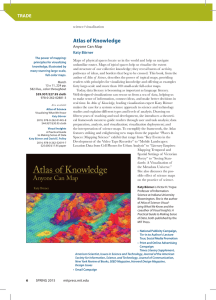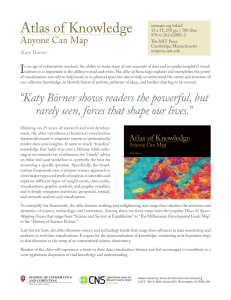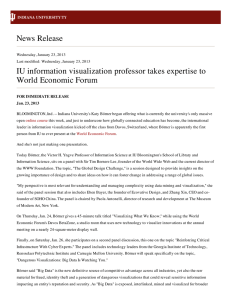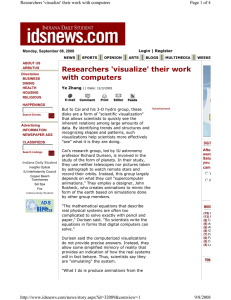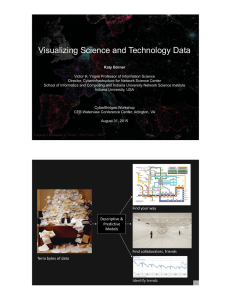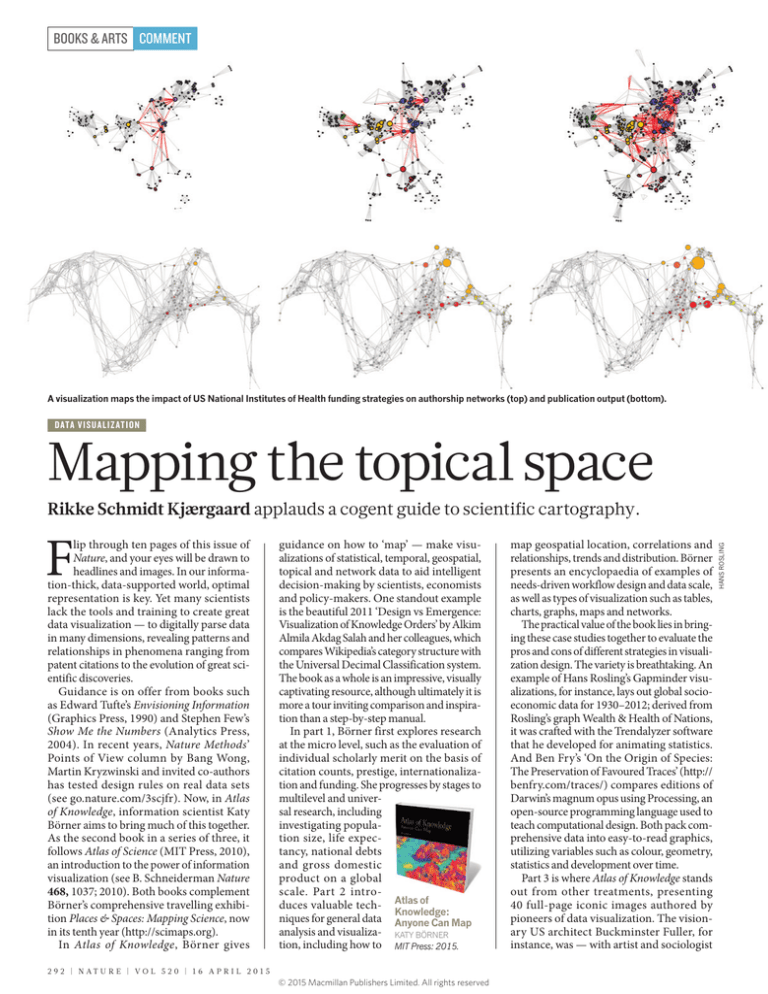
BOOKS & ARTS COMMENT
A visualization maps the impact of US National Institutes of Health funding strategies on authorship networks (top) and publication output (bottom).
DATA VISUALIZATIO N
Mapping the topical space
F
lip through ten pages of this issue of
Nature, and your eyes will be drawn to
headlines and images. In our information-thick, data-supported world, optimal
representation is key. Yet many scientists
lack the tools and training to create great
data visualization — to digitally parse data
in many dimensions, revealing patterns and
relationships in phenomena ranging from
patent citations to the evolution of great scientific discoveries.
Guidance is on offer from books such
as Edward Tufte’s Envisioning Information
(Graphics Press, 1990) and Stephen Few’s
Show Me the Numbers (Analytics Press,
2004). In recent years, Nature Methods’
Points of View column by Bang Wong,
Martin Kryzwinski and invited co-authors
has tested design rules on real data sets
(see go.nature.com/3scjfr). Now, in Atlas
of Knowledge, information scientist Katy
Börner aims to bring much of this together.
As the second book in a series of three, it
follows Atlas of Science (MIT Press, 2010),
an introduction to the power of information
visualization (see B. Schneiderman Nature
468, 1037; 2010). Both books complement
Börner’s comprehensive travelling exhibition Places & Spaces: Mapping Science, now
in its tenth year (http://scimaps.org).
In Atlas of Knowledge, Börner gives
guidance on how to ‘map’ — make visualizations of statistical, temporal, geospatial,
topical and network data to aid intelligent
decision-making by scientists, economists
and policy-makers. One standout example
is the beautiful 2011 ‘Design vs Emergence:
Visualization of Knowledge Orders’ by Alkim
Almila Akdag Salah and her colleagues, which
compares Wikipedia’s category structure with
the Universal Decimal Classification system.
The book as a whole is an impressive, visually
captivating resource, although ultimately it is
more a tour inviting comparison and inspiration than a step-by-step manual.
In part 1, Börner first explores research
at the micro level, such as the evaluation of
individual scholarly merit on the basis of
citation counts, prestige, internationalization and funding. She progresses by stages to
multilevel and universal research, including
investigating population size, life expectancy, national debts
and gross domestic
product on a global
scale. Part 2 introduces valuable tech- Atlas of
Knowledge:
niques for general data Anyone Can Map
analysis and visualiza- KATY BÖRNER
tion, including how to MIT Press: 2015.
2 9 2 | NAT U R E | VO L 5 2 0 | 1 6 A P R I L 2 0 1 5
© 2015 Macmillan Publishers Limited. All rights reserved
map geospatial location, correlations and
relationships, trends and distribution. Börner
presents an encyclopaedia of examples of
needs-driven workflow design and data scale,
as well as types of visualization such as tables,
charts, graphs, maps and networks.
The practical value of the book lies in bringing these case studies together to evaluate the
pros and cons of different strategies in visualization design. The variety is breathtaking. An
example of Hans Rosling’s Gapminder visualizations, for instance, lays out global socioeconomic data for 1930–2012; derived from
Rosling’s graph Wealth & Health of Nations,
it was crafted with the Trendalyzer software
that he developed for animating statistics.
And Ben Fry’s ‘On the Origin of Species:
The Preservation of Favoured Traces’ (http://
benfry.com/traces/) compares editions of
Darwin’s magnum opus using Processing, an
open-source programming language used to
teach computational design. Both pack comprehensive data into easy-to-read graphics,
utilizing variables such as colour, geometry,
statistics and development over time.
Part 3 is where Atlas of Knowledge stands
out from other treatments, presenting
40 full-page iconic images authored by
pioneers of data visualization. The visionary US architect Buckminster Fuller, for
instance, was — with artist and sociologist
HANS ROSLING
Rikke Schmidt Kjærgaard applauds a cogent guide to scientific cartography.
BOOKS & ARTS COMMENT
Books in brief
Beyond: Our Future in Space
Chris Impey W. W. Norton (2015)
Does navigating a pure vacuum while “strapped to a barely controlled
chemical explosion” appeal? Yes — to a select proportion of us,
notes astronomer Chris Impey in this bold, elegant and engaging
exploration of space travel past, present and future. Impey ranges
widely, over a variant of the dopamine-controlling gene DRD4 that
may encourage astronauts to seek novelty; the work of visionaries
such as rocket scientist Konstantin Tsiolkovsky; the trajectories of
national space programmes; advances in robotics and exoplanet
discoveries; the potential for extraterrestrial life; and far beyond.
John McHale — one of the first to chart
long-term trends of industrialization and
globalization. The 1965 chart ‘Shrinking of
Our Planet by Man’s Increased Travel and
Communication Speeds Around the Globe’
maps how the confluence of communication and transportation technologies from
500,000 bc to 1965 have conquered distance.
However, you will need to go to the Places
& Spaces website to fully appreciate the
complexity and interactivity of many of the
twenty-first-century digital visualizations.
For example, in print it is hard to locate the
bacterium Streptococcus pneumoniae on the
2006 ‘Tree of Life’ map by Peer Bork and
his colleagues, which shows 191 species
with fully sequenced genomes. Moreover,
the wealth of examples and illustrations in
Börner’s book is sometimes a bit too rich.
With fewer images, it would have been possible to lead readers into the details, allowing
us to see what is at stake without running
back and forth between book and screen.
Atlas of Knowledge places itself in a long line
of resources on data visualization. The focus
is less on how-to than it was in, say, Felice
Frankel and Angela DePace’s Visual Strategies
(Yale Univ. Press, 2012), but Börner’s book has
a place on my shelf. Whether you read it cover
to cover or just browse the extraordinary
examples, you put it down inspired. ■
Rikke Schmidt Kjærgaard is associate
professor of scientific data visualization and
head of the Visualization Lab at Aarhus
Institute of Advanced Studies, Aarhus
University, Denmark.
e-mail: risk@aias.au.dk
The Prime of Life: A History of Modern Adulthood
Steven Mintz Belknap (2015)
Coming of age, argues historian Steven Mintz, is not what it used to
be. Characterizing adulthood as a “historical black hole”, Mintz sets
out to trace the concept’s trajectory from the nineteenth century to
its 1950s apex, and its disintegration in our individualistic times. He
looks at shifts in intimacy, marriage, parenthood and work, noting that
some 80% of today’s US citizens in their late twenties have yet to tick
off all the traditional indicators of adulthood, such as leaving home.
Yet we need to dig deeper to redefine adulthood, he avers — not least,
by reinstating qualities such as judgement to the definition.
Einstein’s Dice and Schrödinger’s Cat: How Two Great Minds Battled
Quantum Randomness to Create a Unified Theory of Physics
Paul Halpern Basic (2015)
Physicist Paul Halpern tells the entangled tale of Albert Einstein,
Erwin Schrödinger and their search for a Grand Unified Theory with
humour and concision. Schrödinger allied himself with Einstein to
counter the orthodox quantum view championed by Niels Bohr and
others. But as Halpern reminds, Schrödinger was as contradictory as
his famous thought experiment, and Einstein was prone to premature
announcements of theoretical success. A spat between them, he
shows, deprived them of further collaboration, and us of the fruits.
The World Beyond Your Head: On Becoming an Individual in an
Age of Distraction
Matthew B. Crawford Farrar, Straus and Giroux (2015)
In this follow-up to his Shop Class as Soulcraft (Penguin, 2009),
philosopher-mechanic Matthew Crawford looks at the toll that the
assault of constant advertisements, mobile-phone calls and more
are having on our collective psyche. The resulting fragmentation
and dissociation are well documented. Crawford’s solutions —
creating an “ethics of attention” and reclaiming “the real” through,
for instance, craft — are pragmatic, but the rather belaboured
philosophical overlay sometimes wars with his message.
The Archaeology of Sanitation in Roman Italy: Toilets, Sewers, and
Water Systems
Ann Olga Koloski-Ostrow Univ. North Carolina Press (2015)
From aqueducts to amphitheatres, ancient Rome was a hotbed of
engineering. That ingenuity percolated downwards too, as classicist
Ann Olga Koloski-Ostrow shows in this uneven yet enlightening
treatise on sanitation in Roman Italy in the first centuries bc and ad.
Homing in on Herculaneum, Ostia, Pompeii and Rome, she explores
sanitation design, concepts of hygiene and the role of scatology in
the literature and public-toilet graffiti of the time. Barbara Kiser
1 6 A P R I L 2 0 1 5 | VO L 5 2 0 | NAT U R E | 2 9 3
© 2015 Macmillan Publishers Limited. All rights reserved

